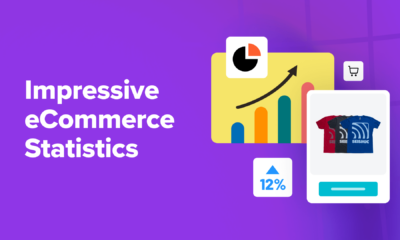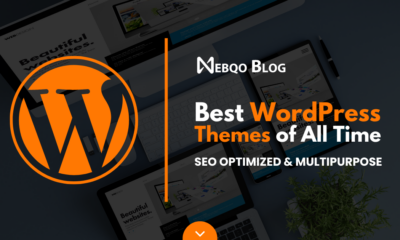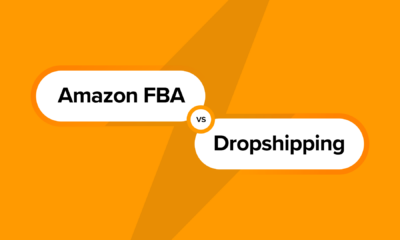WORDPRESS
The 19 Best Print on demand Companies to Consider in 2023 + Tips

Print-on-demand companies follow a dropshipping business model where you contract a print-on-demand provider to help you print books, artwork, t-shirts, mugs, customized items, and handmade items to sell in small batches as needed. You can even have your own brand name attached or your distinctive design printed on each item you sell through your own store online, blog, or social media handle.
In this article, we’ll examine the top 19 best print-on-demand services currently offered so you can choose the best one for your company.
What is Print on Demand?
Print-on-demand (POD) is a business that works with a supplier to customize white-label products such as t-shirts, mugs, covers, notepads, or any other customized merchandise. Once the product is manufactured, you can sell them, on a per-order basis, under your own brand.
This is a great home-based business idea to market your products with your own branding without worrying about inventory while eliminating the need for large print runs and reducing costs, making it ideal for creatives and small businesses.
POD enables businesses to produce high-quality products quickly and cost-effectively while also giving them the flexibility to adjust their production volume as needed. With POD, businesses can offer customers unique and personalized products that can be printed in just a few minutes.
There are two types of print-on-demand companies: print-on-demand marketplaces and print-on-demand service companies. Print-on-demand marketplaces are all-in-one platforms that host your online store on their platform, allowing you to sell the products on your website, build your brand, and grow your own customer base. POD service companies provide production, printing, and shipping services, making them the majority of recommended dropshipping partners.
Can You Make Money with a Print on Demand Business?
The demand for personalization on the part of consumers has helped the growth of print-on-demand sites. Today’s global consumer trends indicate people require more than just functionality and want to buy things that reflect their identities. Everything is tailored to our preferences, including literature, audio, food, cellphone covers, long sleeve t-shirts, and even the information we consume.
Today’s consumers demand a completely personalized internet shopping experience from your online store. They don’t want a straightforward mass-produced product; they want their purchases to reflect their personalities and print-on-demand sites are trying to meet the demand.
In an ever-connected world where personalization is a major buying decision-making factor, POD offers opportunities to expand your business by playing on the economy of scale and the capability that comes through the dropshipping model. Businesses today no longer need to have physical outlets to thrive.
By offering products tailored to your customers’ preferences, including books, cellphone covers, clothing, and other merchandising, you can create your very own niche. Additional perks include the ability to reduce expenses by using the made-to-order model to reduce inventory and production costs.
You don’t have to worry about managing orders, payments, or shipping because there are so many platforms available. All you have to do is concentrate on creating products that are in high demand.
Here’s a quick word from Joe Robert about the best print on demand companies In 2023 on Etsy and Shopify you’ll want to check out after reading:
How print-on-demand companies work
Simply put, print-on-demand companies offer print-after-ordering services to artists, creatives, or businesses engaged in merchandising. Essentially they take orders for your products’ designs and handle the production and fulfillment aspects of the enterprise.
All you have to do is create your own designs and list your products, and start marketing them. When a customer buys a copy, the product is manufactured and mailed to them- the items are produced only after they are ordered for them.
This is a great way to market your products without worrying about inventory while eliminating the need for large print runs and reducing costs, making it ideal for creatives and small businesses. In addition, this print-on-demand model helps businesses to produce high-quality products quickly and cost-effectively while also giving them the flexibility to adjust their production volume as needed.
With POD, businesses can offer customers unique and personalized products that can be printed and delivered speedily. With this new system, you can customize and create virtually any product, from apparel to mugs. Thus helping you to quickly establish an e-commerce business or make your side business ideas turn into a reality.
Which Platform is Best for Print on Demand?
Printify is considered the best print-on-demand business, with over 800 items available in its inventory, including t-shirts, mugs, duvet covers, posters, accessories, and more. Among the services offered include a variety of printing choices, including direct-to-garment printing, cut-and-sew, sublimation, and embroidery.
It also helps businesses produce personalized goods quickly and effectively. It has an easy-to-use UI and is linked with popular online marketplaces like Shopify, Etsy, WooCommerce, Squarespace, Wix Stores, eBay, and more, making it easier for businesses to offer their goods.
The 19 Best Print on Demand Companies
When looking for the best print-on-demand companies, you must consider a number of factors. These include quality of products, customer service, price, turnaround time, integration with dropshipping platforms, ease of use, and general satisfaction. We’ve compiled a list of the top 19 print-on-demand companies based on these criteria to help you make your choice.
We took into account a variety of factors, including their manufacturing capabilities, customer service, whether they serve a specific niche, turnaround time, and pricing. Each of these best print-on-demand companies provides a wide range of products, such as apparel, books, mugs, and accessories, so you can pick the best one for your requirements.
Most of them provide excellent customer service, so you can get answers to your queries quickly and easily. Whether you want a quick turnaround time or a low cost, these best print-on-demand companies will be able to provide you with the best options.
1. Printify
Printify is considered one of the most popular print-on-demand companies. Printify offers a catalog has over 800 products selling everything from t-shirts to mugs, duvet covers to posters, accessories, and more making it easy for businesses to create custom products quickly and efficiently. It comes with an intuitive user interface that allows users to choose a product, personalize it with their own design, and have it shipped directly to their customers.
With Printify, e-commerce companies can offer goods directly on their own site without using other online marketplaces. In addition, it is also integrated with major sales channels such as Shopify, Etsy, WooCommerce, Squarespace, Wix Stores, eBay, and more making it easier for you to easily sell your products.
Pros: Offers integration with various platforms, comes with a mockup generator, offers shipping calculator, extensive product catalog
Cons: According to some reviews, a number of customers have expressed dissatisfaction with the response time to their customer support inquiries, claiming that the service took too long to respond.
Pricing: Printify comes with a free plan where you can manage up to five stores and get unlimited product designs. Paid plans start at a monthly subscription of $ 24.99 and let you manage up to 10 stores per account and get up to 20% bulk discount on all products.
2. Printful
Printful is another option for those who are looking for a reliable and cost-effective print-on-demand service. It offers a wide variety of products and services, including custom t-shirts, hoodies, hats, mugs, tote bags, and more.
It offers intuitive design tools that let you create unique pieces, even if you have no design experience, while integrating with popular eCommerce platforms like Shopify and WooCommerce. In addition, it offers a wide range of customization options, including printing, embroidery, and sublimation.
Pros: Offers discounts for bulk orders and monthly volume, promotes eco-friendly products, comes with mockup generator and pre-made designs.
Cons: Offers higher production costs than other print-on-demand companies; the product line on offer is more limited than other print-on-demand sites.
Pricing: Printify comes with a free plan where you pay only for the products you buy or sell after an order is made. If you want more features in addition to the free plan, Printify offers extra fees.
3. Sellfy
Sellfy is an e-commerce platform for creators who want to sell a variety of goods, such as hoodies, shirts, phone cases, bags, and more. In addition to physical products, they also sell digital products. It allows you to quickly launch your online business idea or print-on-demand merchandise store. It has a shopping cart feature that allows you to make more money by enabling your customers to add multiple items to their online shopping carts at once.
Even better, you can design a mobile-friendly checkout process and online store for desktop and mobile users. Additionally, it has some excellent marketing features, such as upselling, email marketing, and discount codes. More than 60,000 creators have used Sellfy to sell their goods since it launched in 2011, generating more than $100M in total revenue.
Pros: Sellfy offers multiple payment options, built-in marketing tools, and customizable online storefronts
Cons: There are a few integrations available.
Pricing: Paid plans start with monthly charges ranging from $19 to $99. There is also a 14-day free trial.
4. SPOD
SPOD is a print-on-demand company that lets you create and sell your print-on-demand products. With it, you can create a custom product line within minutes, print, and ship your merchandise in 48 hours or less, according to SPOD half of its orders ship within 24 hrs. You can start selling, printing, and dropshipping by uploading your designs or creating your own with SPOD’s free graphic library of over 50,000 designs.
The library lets you create and personalize over 200 print-on-demand merchandise items. SPOD integrates with WooCommerce, Magento, Squarespace, Shopify, and others- it even has its own mobile app.
Pros: 48-hour order fulfillment, vast graphic library, over 200 POD merchandise items
Cons: You can’t use it unless you have a Shopify account.
Pricing: When using SPOD, there are no ongoing costs. SPOD charges only the order value and the shipping costs of the items when an order is placed. The cost of shipping is determined by the order value, shipping type, and country.
5. CustomCat
CustomCat helps businesses to create and sell unique products from images they upload, and publish to their store. It allows anyone to create unique and high-quality custom goods whether ordering only one item or 1,000 items while at the same time offering a manual order feature for those without e-commerce experience.
With it, you can sync existing product listings from your online store to CustomCat seamlessly, create product templates and mass publish product listings with bulk tools, manage product listings, view stock status and edit fulfillment settings, and manage all aspects of orders and fulfillment. CustomCat also partners with e-commerce sellers such as Shopify, Etsy, WooComemrce, and BigCommerce and ships products globally.
Pros: CustomCat allows users to create product templates, manage listings, view stock status, and manage orders and fulfillment.
Cons: Most of CustomCat items are limited to apparel, accessories, and housewares.
Pricing: CustomCat is free to sign up for and use. When an order is placed in a store, customers pay for the base cost of the items plus the cost of shipping them to their customers. The PRO subscription comes with a $25 monthly fee and offers users 20-40% off CustomCat’s custom wholesale prices.
6. TeeLaunch
TeeLaunch is a print-on-demand e-commerce platform for art, prints, apparel, and more. It offers an affordable print-on-demand option for entrepreneurs looking to create unique merchandising. Teelaunch will accept orders from your web store, prints the product, and handles the fulfillment end.
Thanks to its user-friendly interface, it uses the power of Shopify to make mockups, and products and set up automatic order fulfillment in just minutes. Besides integrating with Shopify it also works well with other third-party platforms such as Etsy and WooCommerce.
Pros: There are no monthly costs, it has a simple-to-use interface, offers a good selection of merchandising options.
Cons: Some reviews complain of shipping delays.
Pricing: Teelaunch comes with a free plan where you pay only for the products you buy or sell after an order is made.
7. Zazzle
Zazzle’s print-on-demand service lets you create, sell, and buy T-shirts, hoodies, and other merchandise. With its easy-to-use design interface, you have access to a large selection of templates, apparel designs, colors, and sizes to customize the final product.- even if you’re not a designer. Creating an item on Zazzle is a simple process that can be completed in a few minutes.
To create a design, all you need to do is choose a template and add content. This can be done in a variety of ways, such as through text, and images. Once you’ve added content, you must choose a price and add your design to your account.
Zazzle however does not have direct integration for third-party e-commerce stores such as Shopify, but you can however use Zazzle’s Application Programming Interface (API) to integrate with other platforms.
Pros: Delivers good high print quality products, products can be customized by buyers, and affiliate marketing opportunities are available.
Cons: Does not integrate directly with e-commerce platforms like Shopify, Etsy, and WooCommerce
Pricing: There is no cost to sign up. Designers can set their prices between 5% and 99% higher than Zazzle’s basic price.
8. SPOD
SPOD is a print-on-demand service company that lets you create and sell your print-on-demand products. With it, you can create a custom product line within minutes, and print and ship your merchandise in 48 hours or less, according to SPOD half of its orders ship within 24 hrs.
You can start selling, printing, and dropshipping by uploading your designs or creating your own with SPOD’s free graphic library of over 50,000 designs.
The library lets you create and personalize over 200 print-on-demand merchandise items. SPOD integrates with WooCommerce. Magento, Squarespace, Shopify, and others- it even has its own mobile app.
Pros: 48-hour order fulfillment, vast graphic library, over 200 POD merchandise items
Cons: You can’t use it unless you have a Shopify account.
Pricing: When using SPOD, there are no ongoing costs. SPOD charges only the order value and the shipping costs of the items when an order is placed. The cost of shipping is determined by the order value, shipping type, and country.
9. Redbubble
Redbubble is another option for independent artists looking to offer print-on-demand products through their existing website or through marketplaces such as Amazon, Etsy, and eBay. This print-on-demand solution gives you the tools you need to design products and works for artists of all skill levels from novices to experts.
Thanks to its built-in design maker you can create intricate, eye-catching designs and mockups for your products to sell on redbubble. It also offers a wide range of merchandising products from eco-friendly to premium clothing that includes stationery, wall art, home and living, accessories, apparel, and more.
Pros: Large customer base and traffic, anti-piracy features to protect artists’ artwork, has an affiliate program
Cons: Potential low-profit margins, high competition
Pricing: Redbubble charges a base price which includes a service fee for hosting the marketplace as well as the third-party manufacturer’s manufacturing fee.
10. GearLaunch
GearLaunch is another choice for a print-on-demand company that offers a dependable and cost-effective solution. It provides a simple, no-hassle printing experience, with no minimum order requirements and a wide range of materials including paper, canvas, and apparel.
GearLaunch functions in a straightforward manner: you create the designs and choose your ideal products and GearLaunch handles the manufacturing and delivery. You only pay the base price for products and if you want to integrate with Shopify you can opt to use its API.
Pros: A good selection of Print on Demand products, no minimum orders
Cons: Does not directly integrate with other platforms besides Shopify
Pricing: The GearLaunch platform is free, and Shopify has a free option as well. There is a $4.99 monthly fee involved with upgrading your Shopify platform.
11. Amazon Merch on Demand
Amazon Merch on Demand helps users sell their branded products created by them to be manufactured, sold, and shipped by Amazon. A key selling point here is that Amazon prints and ships products faster than most other POD fulfillment services. Because Amazon is both a massive marketplace and one of the most popular search engines on the internet, you should be able to reach more customers at Amazon Merch on Demand than anywhere else.
Signing up is easy as Amazon Merch on Demand is free to create an account, upload content, and free to sell on the platform. Amazon also offers Print on Demand and Amazon Custom where customers can buy customized goods. With the help of these services, customers can develop unique products with their own artwork, logos, and text, and have them printed and delivered within a few days.
Pros: Huge reach, high potential for conversion rate, perhaps the fastest shipping service
Cons: Limited branding options, high competition.
Pricing: Amazon Merch is an on-demand printing business where sellers make and list free t-shirt designs on Amazon. There are no out-of-pocket expenses, and you are paid royalties when a client purchases your shirt.
12. Sunfrog
Sunfrog is a print-on-demand service offering a wide range of products from clothing to accessories, flyers, notebooks, mugs, and banners. They offer high-quality prints, with quick turnaround times, and competitive prices offer high- print quality for a wide selection of designs. Once signed in as a seller Sunfrog will make promotional images for you at no cost so that you can promote yourself to your customers.
It also offers users campaign tracking codes to help you get on top of your marketing campaign. In addition, Sunfrog pays a 10% commission on all sales to artists and enables you to set your own prices. Each item, however, has a minimum and maximum price that can be charged. It is also integrated with major sales channels such as Shopify, Big Commerce, and Magento.
Pros: No minimum sales requirement to have the merchandise printed, comes with a featured artist section, to promote your work and increase sales, easy to use dashboard that displays real-time statistics such as traffic, sales, and conversion.
Cons: Initially, profit margins may be modest.
Pricing: SunFrog is completely free to use, and you make money by creating items and earning a 15% commission on sales. If you are an artist, you will also receive a 10% commission on each piece sold.
13. JetPrint
JetPrint is a print–on–demand company, offering over 400 products from shoes, jewelry, watches, and clothing to bags, rugs, shower curtains, and more. With JetPrint’s mockup generator, you can automatically create and publish products using you’re your artwork or your own custom design and even include your own logo.
You can also process orders automatically and even set a time limit that enables you to make changes or corrections if necessary. JetPrint offers integration with Shopify, Etsy, and WooCommerce, making it simpler and faster to promote and sell your unique merchandise.
Pros: Good selection of merchandising products, good custom design options, availability of payment integrations.
Cons: Lead times for production in some cases could take between three to five days.
Pricing: JetPrint charges a base price.
14. Teespring
Teespring initially began as the best print on demand for selling designed t-shirts. Today it has become a print-on-demand order fulfillment company, producing leggings, hoodies, décor, phone cases, and more.
Teespring is a free platform that allows creators and influencers to develop, promote, and sell products without incurring any costs or risks. Teespring offers order fulfillment, customer service, and shipping. In exchange, creators can determine the selling price and keep 100% of the profit.
Pros: Integration with social media platforms and other marketing channels, free-to-use, easy-to-use design feature.
Cons: Small margins for small volume production, Teespring makes more sense if you have a large volume of orders to fulfill.
Pricing: Spring is completely free to use. You determine the selling price and retain the entire profit.
15. TeeChip
TeeChip is a print-on-demand platform that lets users create their own unique merchandising and sell directly to their fans. With it, you can sell a wide variety of products including posters, mugs, hoodies, gats, phone cases, and t-shirts. Working with TeeChip, there is no risk because there are no upfront costs. When it comes to, the payment TeeChip accepts credit cards, debit cards, wire transfers, and PayPal.
Pros: A good selection of customizable products, simple sign-up procedure with no costs.
Cons: According to Teechip orders are usually shipped within 5-20 working days.
Pricing: TeeChip deducts the base price from the purchase each time you sell and provides you the margin you specify.
16. Printy6
Printy6 is a print-on-demand service that makes it easy for businesses to create and order custom-printed products. Businesses can quickly design their own products with intuitive tools, upload artwork, and order high-quality prints in no time thanks to Printy6’s innovative technology and user-friendly platform.
Printy6 integrates with many online stores, including Shopify, Etsy, BigCommerce, Woocommerce, and Amazon. It offers professional-level image rendering services to make your images stand out thanks to its photorealistic rendering feature. It uses premium fabrics and an eco-friendly printing process and provides a money-back guarantee if there are any quality problems.
Pros: Easily integrates with your own online store, offers cheaper product costs compared to other print-on-demand , offers customized brand packaging
Cons: Some reviews complain about longer fulfillment times than other competing print-on-demand sites, and most of its products are focused on apparel.
Pricing: Printy6 app is free to use
17. Gelato
Gelato is a print-on-demand site for a range of products that include clothing, wall art, Mugs, Photobooks, Cards, Stationery, tote bags, and more. With more than 130 production partners spread across 32 nations, it makes it simple for customers to have their products produced and delivered without hassle while lowering their carbon footprint.
The option to select the shipping speed, live order tracking, shipping discounts, and more benefits are included. Additionally, it integrates with all of the leading online shopping carts, including Shopify. Platforms like Shopify, Etsy, WooCommerce, Wix, Squarespace, BigCommerce, and others are integrated with it.
Pros: Offers local production options, affordable pricing, has a mobile app, tracks shipments, and offers basic analytics.
Cons: Limited selection of product options with categories swaying more on apparel and basic stationery
Pricing: Gelato is free to join with no minimum purchases required and get access to integration with Shopify, Etsy, and WooCommerce. Paid plans begin at $ 14.00 per month, and you can get millions of stock photos, premium mockups, and 30% off standard shipping as well.
18. Gooten
Gooten is a dropshipping platform that specializes in print-on-demand services. It offers a wide range of products, from fashion and apparel to home decor, to wall art and accessories. It comes with a robust suite of tools and services to help users launch and scale their businesses. Its major selling points include its easy-to-use platform, extensive product catalog, and competitive pricing.
Gooten integrates with Big Commerce, Shopify, WooCommerce, and Etsy. Its automated order fulfillment system makes sure that orders are usually processed and shipped within 24 hours. It also offers a loyalty program ‘Very Important Merchant (VIM)’ where you get more tailored solutions and support to help grow your online business.
Pros: Versatile product catalog, integration with major platforms, and great loyalty program.
Cons: Its product mockups don’t look as good as those from other print-on-demand companies.
Pricing: The base cost of the item and the price of printing are both included in the prices listed in Gooten’s Product Catalog. You can charge and set your own margins, but don’t forget to factor in shipping and fulfillment costs.
19. Society6
If you are an independent artist or a creative Society6 can be a great option for a print-on-demand site. With it, you can sell a wide variety of products, including wall art, t-shirts, phone cases, and home furnishings. Users can also upload their own artwork to create truly one-of-a-kind items.
Similarly, Society6 has reasonable prices and a simple website. Its customer service is also well-known for its quick responses. Because of its extensive product selection, low prices, and excellent customer service, Society6 is an excellent choice for those looking for the best print-on-demand companies.
Pros: Great for newly emerging artists, helps to create marketplace visibility for your artwork and offers networking opportunities in its online artist community.
Cons: You are only able to sell your products through the Society6 website as it is unable to integrate with Shopify, Etsy, or other platforms.
Pricing: Society6, does not have any monthly fee, you receive a 10% commission on the base price of your artwork.
How to Choose the Best Print on Demand Company

There are many great print-on-demand companies out there, each offering its own unique services and features. it comes to choosing the right print-on-demand company, there’s no one-size-fits-all solution. Each print-on-demand business has its own distinct strengths, weaknesses, and features, but how can one choose the best print-on-demand business? Here are some features to consider:
- Offer quality products: For an enterprise to succeed, it will need to create products of the highest quality. So it is important to shortlist a few prospective print-on-demand suppliers and order test samples from them to get a sense of their quality standards.
- Speedy Shipping: Customers expect fast shipping times when shopping online. You will need to deliver on this promise if you want to establish a good reputation and earn repeat business. When choosing a print-on-demand company, it is important to consider the average shipping time. Ideally, customers should receive their products within one week of placing an order.
- Reasonable production costs and shipping: Business is all about generating enough revenues to help your business thrive and grow. Reasonable production costs and shipping rates come in handy for your business’s success. Choosing a print-on-demand company with high product and shipping fees may result in smaller margins, hindering growth. Look for a print-on-demand company that offers a reasonable production cost without compromising quality.
- Offer Customization and printing options: Good print-on-demand companies will offer different customization and printing options, depending on your needs. Great print-on-demand companies, in addition to this, will offer packaging options that suit your design and branding needs.
- Offer Integration with other platforms: Different print-on-demand companies allow you to sell through a variety of channels, such as your own website, Shopify, Etsy, eBay, Amazon, and other platforms. Make sure your print-on-demand company accords you with the means to grow your business by offering you these options.
It is important that you start your selection for the right print-on-demand partner from a pool of likely candidates while making sure not to make too many print-on-demand mistakes. Besides inquiring whether the provider provides the services you require and has a good track record with customers, you should check the company’s refund policy. Check to see if they can offer you cutting-edge technology at a reasonable price.
Here’s a numbered comparison table for choosing the best print-on-demand company:
| iteria | Importance | Print-on-Demand Company A | Print-on-Demand Company B | Print-on-Demand Company C |
|---|---|---|---|---|
| 1. Quality Products | High | ? | ? | ? |
| 2. Speedy Shipping | High | ? | ? | ? |
| 3. Reasonable Costs | High | ? | ? | ? |
| 4. Customization & Printing | Medium | ? | ? | ? |
| 5. Integration with Platforms | Medium | ? | ? | ? |
| 6. Refund Policy | Low | ? | ? | ? |
| 7. Cutting-edge Technology | Low | ? | ? | ? |
Note that a check indicates that the company meets the criteria, while an X indicates that the company does not meet the criteria. The importance levels are subjective and may vary based on individual business needs. Conduct thorough research and compare multiple print-on-demand companies to find the best fit for your specific requirements.
How to Make Money with Print on Demand

If done right, venturing into a print-on-demand business can be lucrative and comes with minimal risks. Print-on-demand offers low startup costs and quick setup without the need for inventory and storage, and is easy to experiment with product designs. It also offers you the ability to customize and sell your unique designs to a global market, scale, and test new products without financial risks.
Let’s also not forget that most print-on-demand businesses frequently provide discounts for bigger orders letting you to further increase your profit margins. Most importantly, it can boost your online store’s chances of success while at the same time making money by creating your own brand that is distinct.
Ultimately the amount of money you can earn with Print on Demand is dependent on the goods you offer, your target audience, and how well you advertise to them. Some great ways to make money with print-on-demand include:
- Partner with platforms that can boost your touch points: There are several platforms that can help you bring to scale your sales and boost your earnings. For example, platforms like Shopify, Etsy, and Amazon can increase your reach and help with some of the heavy lifting for you.
- Make the most of social media marketing: Social media offers a tremendously and powerful instrument for promoting your print-on-demand goods. Facebook, Instagram, and Twitter not only increase your customer touch points but also add to your credibility and boost engagement with your target audience. With some effort, you can develop a loyal customer base that will keep coming back for more.
- Uniqueness and personalization sell: To succeed, you will need to fine-tune you’re branding and design so that you represent a distinct personality – this is what will make you stick out from the competition. Consider using unique typefaces and eye-catching graphics. Also, keep an eye on what is trending for print-on-demand goods to stay ahead of the curve.
- Create realistic mock-ups: It’s always a good idea to make mock-ups of your products on real individuals when offering a print-on-demand product. This enables you to demonstrate your products in real-world settings and doesn’t come off as a scam. This is also excellent for sharing on social media.
- Harness the power of testimonials and reviews: When it comes to promoting your print-on-demand goods, customer feedback can go a long way in terms of establishing your credibility. If you have satisfied clients who to sing your praises, make sure to clearly display their testimonials on your website or social media sites.
This is an excellent method to establish trust with prospective customers and demonstrate to them that your goods are worthwhile investments. Always remember reviews and testimonials are the new social proof!
Finally, it’s important to note that success with a POD company often requires patience and consistent effort. While some individuals and businesses have achieved significant success and generated substantial income through POD, others may experience more modest results. Like any business venture, there are risks and uncertainties, but with dedication, creativity, and strategic planning, you can increase your chances of success in the print-on-demand industry.
Best Print on Demand Services FAQ

There are several print-on-demand sites, and the best one for you will be determined by your particular requirements. You will need to consider the kinds of products you want to produce, the quantity required, the quality of the product, the turnaround time, and the expense without any hidden fees.
Can you start print on demand with no money?
Yes, you can start printing on demand with no money. You can build your own online store using a free platform like Shopify, or you can use a free tool offered by many print-on-demand service companies to help you with fulfilling your orders. When it comes to designing, print-on-demand companies come with free mock-up generators as well as free templates and designs online to use for your products.
If you are a creative designer you can offer designs in the form of digital products to others and receive royalties in exchange. In some cases, a good print-on-demand site will even help you calculate your business costs and help set a price to help set prices for a cozy profit margin.
Which print on demand service is most profitable?
There are several print-on-demand service choices available in the market, each with its own set of benefits and disadvantages. Ultimately, the most profitable print-on-demand service will be the one that best meets your particular business’s requirements.
For example, Printful is an excellent choice if you want a print-on-demand service that is quick and simple to use. It also comes with a variety of custom products, so you can choose the ideal product to sell. Zazzle is another well-known print-on-demand business that has a broader selection of products and customization choices.
Is Print-on-Demand Still a Good Business?
There’s no doubt that print-on-demand (POD) continues to open markets for creatives, artists, and small businesses engaged in merchandising. It offers a quick, easy, and affordable way to print and distribute books, artwork, merchandising, and more on a global scale.
It is a great alternative for creatives who want to get their custom products into the hands of their fans without incurring the high costs of traditional printing, storage, and distribution. The major draw for POD is that it allows entrepreneurs much leeway in their manufacturing as production is on an as-needed basis.
What Are the Best Quality T-Shirts for Printing?

There are several factors to consider when looking for the finest quality T-shirts for printing. The first thing to think about is the sort of printing you want to do.
For example, if you want to screen print, you’ll need to use a material made of a thicker substance to keep the pigment from bleeding through the blouse. And if you want to do digital printing, you would want to opt for a T-shirt made from a thinner material to improve the ink clearly printed on the garment.
Is dropshipping better than print on demand?

Though both dropshipping and print-on-demand share many features print on demand has an edge over drop shipping. Doprshipping companies or eCommerce suppliers offer goods and services to online merchants and are limited to marketing, fulfillment, and transportation. The dropshipping industry is more cutthroat than the print-on-demand market as there is little differentiation among the products that are up for sale.
Print on demand, however, has an element of uniqueness when it comes to the product as they are designed by a particular artist, creative or small business. If you want to build a long-lasting and consistent image with customers and carve out your own niche then print-on-demand can be a good option.
Image: Envato Elements
WORDPRESS
90+ Impressive eCommerce Statistics You Won’t Believe (2024)
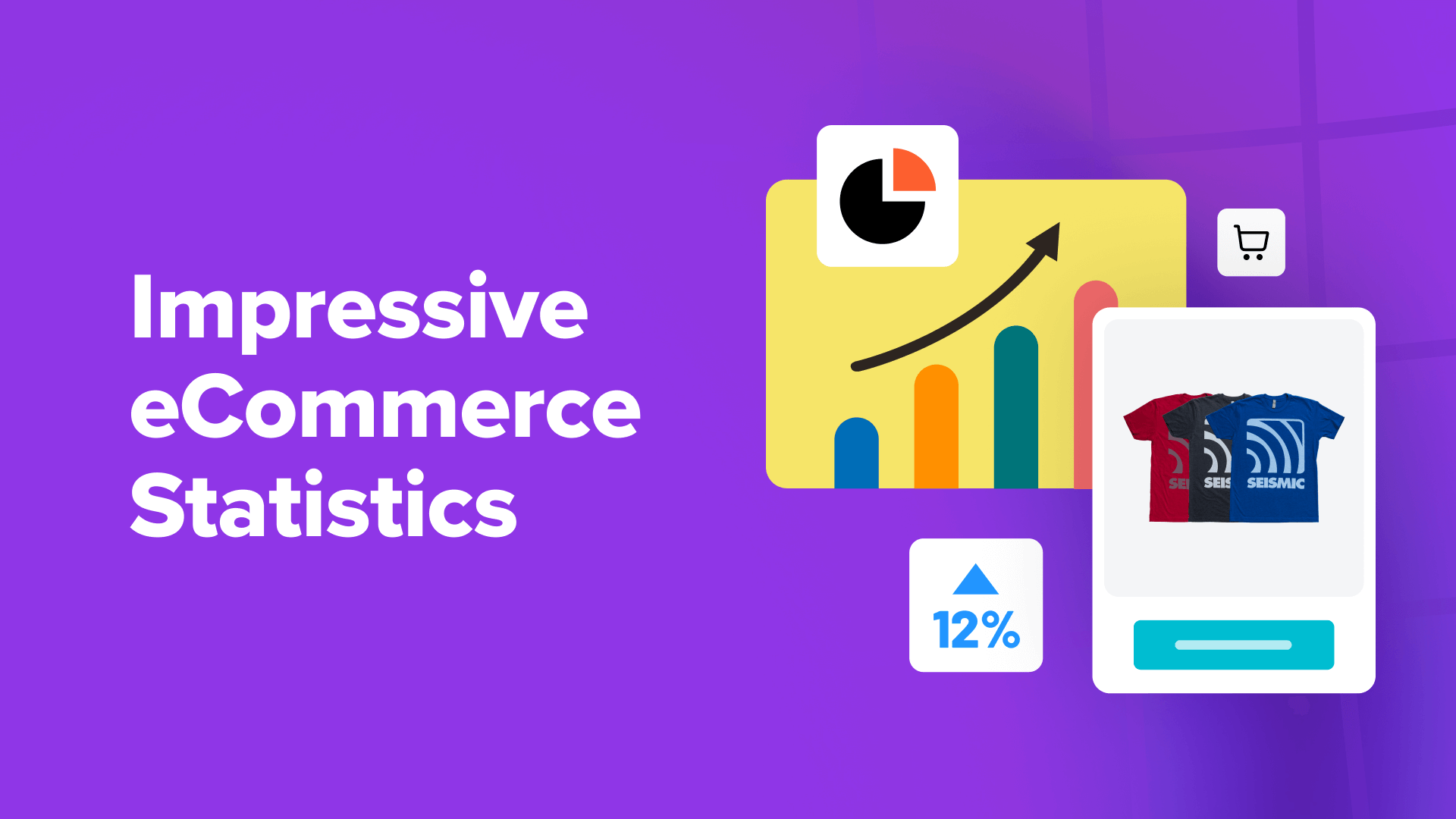
Are you ready to see some eCommerce statistics that will help you take your online business to the next level?
It’s safe to say that in the last 20 years, eCommerce has grown beyond our wildest expectations. And it’s still evolving faster than ever. If you want to keep your customers happy and build a relationship with new prospects, you need to stay current on the latest stats and insights.
In this post, we will share some of the best and most relevant eCommerce statistics of 2024. Our goal is to help you stay informed and make meaningful, data-driven decisions the next time you work on your website or marketing strategy.
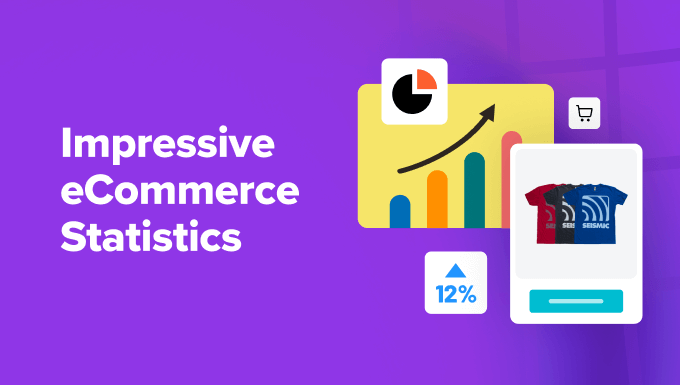
Ultimate List of eCommerce Statistics
Before we get started, here’s a list of all the topics we will be discussing today. Feel free to jump to the part that catches your attention or read the whole thing from top to bottom!
General eCommerce Statistics
First, let’s start with some statistics about the general state of eCommerce and online stores.
1. Globally, there are over 12 million eCommerce websites.
Over 12 million eCommerce websites might sound like a saturated market at first glance. But you will be happy to know the answer is a little more complex than that.
While competition is fierce for online stores, this statistic also shows that this is a growing market and there’s room for new business owners across all industries. The keys to success are to choose your target audience, cater to their goals, needs, and pain points, and create a website that separates you from everyone else.
By catering to a specific audience and offering a unique, memorable customer experience, you can carve out your own spot in the eCommerce world. Remember, even giants like Amazon started small, so there’s room for you to succeed, too.
2. More than 80% of US shoppers say they occasionally buy from eCommerce stores.


If your goal is to get more customers, then this statistic is very exciting. Business owners across all industries can be sure that their audience is out there and interested in their products and services. All they have to do is reach them.
If you’re in this position, make sure you start an online store with a blog and write plenty of great content so people have a reason to stay once they discover your site.
Think about it this way: four out of every five in a population of 331.1 million is about 265 million people! And that’s just in the United States.
3. It’s estimated that the eCommerce market will be worth $6.8 trillion by the end of this year, an almost 10% increase year over year.
The eCommerce market share is currently projected to hit a whopping $6.8 trillion by year’s end – that’s a 10% leap from last year!
This huge growth is fantastic news for both established businesses and those just starting out.
For veterans, it means a bigger customer pool to tap into. With more consumers shopping online, there’s a chance to expand your reach and grow your brand in new and exciting ways.
New businesses can also benefit from this boom. As more people shop online, they are more open to discovering new brands. This presents a golden opportunity to get your foot in the door and establish yourself in the market.
4. Amazon made close to $575 billion in net sales revenue in 2023, making it the biggest eCommerce seller in the world.
There’s no question that Amazon’s success shows the potential of online sales. We were shocked to find that 44% of shoppers check Amazon for products before they turn to Google.
But here’s the thing – they aren’t the only ones profiting. The entire eCommerce market is thriving and ready for smart, dedicated people who want to build customer-centric products and services. This means there’s space for you to win, too.
5. When it comes to eCommerce platforms, WooCommerce leads the pack, with over 6.6 million active users.


WooCommerce is the most popular eCommerce platform, with an eCommerce market share of 37.7% and 6.6 million users.
For context, Squarespace Online Stores takes second at 14.67%, and WooThemes takes third at 14.95%. The runner-ups are popular enough, but they don’t compare to WooCommerce.
People prefer to use WooCommerce to start a store because it’s user-friendly, flexible, and comes with tons of great features and integrations. Plus, it’s customizable so you can use it to create an online store that matches your vision.
More General eCommerce Statistics
- Across all industries, the average conversion rate on an eCommerce website is 2.86%.
- The top four drivers of online purchases are free shipping (49.4%), discounts (37.9%), customer reviews (31.6%), and an easy return policy (30.4%)
- The largest group of online shoppers are people between the ages of 25 and 34.
- Nearly 55% of people prefer shopping online over traditional brick-and-mortar stores.
- China contributes the most to the eCommerce market share, as it is responsible for 52.1% of all eCommerce sales.
- But India is the fastest growing market, with a projected growth of 14.11% between 2023 and 2027.
- There are 604 eCommerce platforms to choose from.
eCommerce Marketing Statistics
Marketing is key to an online store’s success. Let’s now take a look at some eCommerce marketing statistics.
6. eCommerce businesses with three or more marketing channels see 251% more engagement than those that stick to a single marketing channel.


Standing out online requires reaching your target audience, and this stat makes it clear: using just one marketing channel limits your reach. And if you can’t connect with your audience, then it’s hard to grow your eCommerce business.
The solution is actually quite simple – add more ways to get your message out, and you’ll unlock more opportunities to reach potential customers.
We suggest investing heavily in email marketing, social media outreach, and search engine optimization (SEO) since these are three of the best ways to generate traffic and conversions.
7. Content marketing helps brands generate 3x more leads than their non-blogging counterparts.
Imagine getting 3x more leads just by writing informative blog posts! That’s the advantage that content marketing offers.
Businesses that blog regularly see a huge jump in leads. Here’s why it works: blogs attract potential customers looking for answers.
By consistently creating helpful content related to users’ goals and interests, you can build trust and become an expert in their eyes. This makes them more likely to choose you when they are ready to buy. It’s like giving away valuable advice to build relationships—and ultimately, sales.
Our advice is to spend plenty of time doing keyword research so that you know what matters to your target audience. It’s much easier to create eye-catching content if you know what matters to your audience.
8. 71% of shoppers expect businesses to use personalization in their marketing and 76% get frustrated when that doesn’t happen.
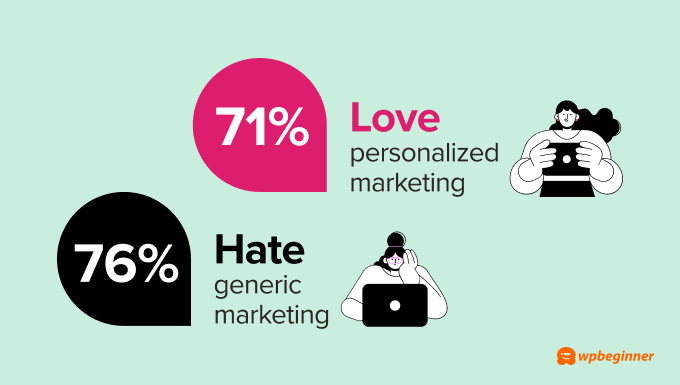

Forget one-size-fits-all marketing. Today’s shoppers crave personalization, and the numbers back this up. A vast majority of shoppers want businesses to use macro and micro-personalization in their marketing, and people get annoyed when that doesn’t happen.
Including things like an email subscriber’s first name or referencing a product they purchased in the past shows that you are paying attention and want to build rapport to help them reach their goals.
If you don’t personalize at least a few parts of your marketing campaigns, then you may struggle to generate leads and connect with your prospects.
Similarly, if someone buys from your site and doesn’t see personalized messages or offers based on their interaction, they may choose another business that offers these experiences the next time they need to make a purchase.
The best way to personalize your audience’s experience is to use tools like OptinMonster or FunnelKit. Both of these plugins allow you to show personalized content to each visitor.
For example, if someone is looking at a specific product page, you can use OptinMonster to create a popup that only shows up on that page with a unique offer. This is a great way to drive sales and grow your email list.
9. SEO marketing matters, because search engines are the number one way people discover new products (30.6%).
SEO is more important now than ever before. Most people discover products through search engines, with TV and word-of-mouth coming in second and third place respectively.
If your site does not appear on search engine results pages (SERPs), you are missing out on a massive chunk of potential customers. The good news is that there are plenty of ways to optimize your site for search engines.
All in One SEO (AIOSEO) is the best WordPress plugin you can use for the job. Currently, over 3 million people use it to check their on-page SEO, optimize their websites, and so much more. It’s a great tool for beginners and experts alike because it manages to be both user-friendly and has plenty of advanced features.
If you want to know more, just check out our Ultimate WordPress SEO Guide for more information.
More eCommerce Marketing Statistics
- Video is a powerful marketing tool, with 73% of people saying they’d be more likely to buy a product if they could watch a video about it first.
- 75% of shoppers say they need to see photos of a product before they buy it.
- eCommerce advertising influences over 56% of in-store purchases.
- Ad spending for eCommerce is worth $38.4 billion, which is 3x what it was in 2019.
- 75% of shoppers say they’ve used a paid search ad on Google to find a new product.
- Nearly three-fourths (73%) of people shop across multiple marketing channels.
Mobile eCommerce Statistics
Mobile browsing is more popular than ever, and the same goes for mobile shopping. Here are some key eCommerce statistics for mobile shoppers.
10. 71% of U.S. shoppers say they’ve made a purchase from their mobile phone.


This stat is a wake-up call for all eCommerce business owners: having a mobile-friendly website is no longer optional. It’s necessary.
If your website isn’t easy to navigate and use on a smartphone, then you are missing out on a ton of traffic and potentially losing a huge chunk of sales.
Mobile optimization includes things like a smooth user experience, clickable calls-to-action, fast loading times, and a layout that adapts to different screen sizes. By prioritizing mobile users, you will be meeting your customers where they are and making the buying process as convenient as possible.
For more details, you can see our guide on how to create a mobile-friendly WordPress website.
11. During Q3 of 2023, 74% of all eCommerce visits happened via mobile.
Based on this statistic, it’s clear how people prefer to browse websites and shop online. This means you need to go beyond a responsive design and instead focus on creating a mobile-first experience.
Imagine what would happen if 3 out of 4 people who visited your site had trouble browsing your product landing page, contacting your customer support, or reading your blog. Odds are, you’d see a significant dip in engagement.
If you follow mobile-first practices, then you’ll be in a much better position to capture your audience’s attention and turn them into customers.
12. 40% of shoppers say they are likely to leave an online store if it isn’t optimized for their device.
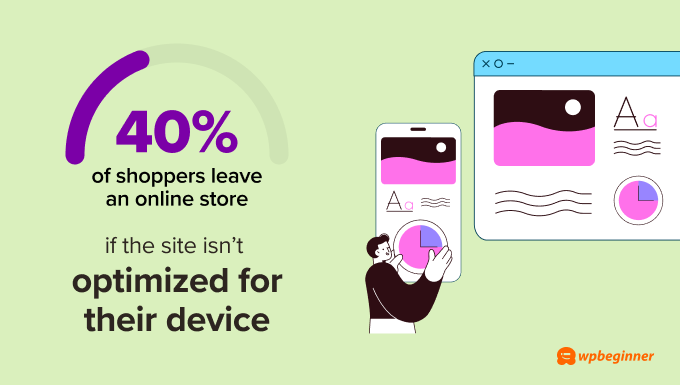

At a glance, it’s concerning to see that almost half of shoppers say they’ll leave a site if it’s not optimized for mobile. This could lead to a significant portion of potential customers bouncing off your website, simply because it isn’t user-friendly.
The good news is there’s a solution: SeedProd. It is one of the best page builders on the market and features a responsive option that allows you to fine-tune how your website displays on desktops, tablets, and mobiles. This ensures a smooth user experience for all visitors, regardless of their device.
Expert Tip: If you are looking for a different option for building a mobile-friendly website, Thrive Architect is another great choice!
More Mobile eCommerce Statistics
- The average mobile order is between $90 and $110, which is less than the average desktop purchase.
- However, mobile eCommerce is growing faster at 29%, which is better than the 22% growth rate of desktop eCommerce.
- In the United States, there are 187 million active smartphone shoppers.
- Mobile apps convert 3x more customers than mobile websites.
- 49% of smartphone shoppers use their devices to compare prices of different products when shopping online.
- 38% of shoppers say they’ve never used a mobile device to shop, while 7% report never using desktop computers to make a purchase.
eCommerce Payment Statistics
Next, let’s see some impressive eCommerce statistics for online payments.
13. When it comes to paying for online orders, credit cards are still the most popular payment method, making up 53% of transactions.
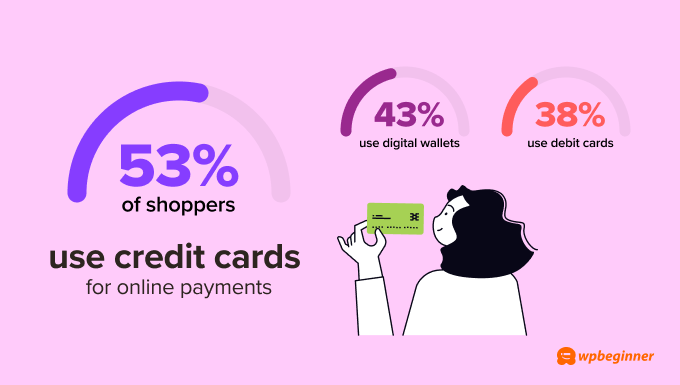

Credit cards might reign supreme for now, but the future of eCommerce payments is digital. While a solid 53% of customers still prefer credit cards, this statistic shouldn’t overshadow the rise of digital wallets and debit cards, which follow closely behind at 43% and 38%.
There’s no question that digital payment methods, like Apple Pay and PayPal, offer a faster, more convenient experience for shoppers, so integrating them into your website can dramatically boost conversions.
The bottom line is every step a customer has to take to complete a purchase adds friction to the process. Digital wallets eliminate the need to manually enter card details, which will streamline your checkout process and result in more happy customers.
14. In one survey, half of eCommerce business owners say they lose about 10% of their international revenue because their payment vendors do not have flexible payment options.
Not having the right payment gateway on your site will result in people leaving without taking action. You don’t want to put your visitors in this position because not only are you leaving money on the table, but there’s a good chance they will not come back even if you add their preferred payment method later.
The solution is to offer a wide range of payment methods as soon as possible. When customers have options they trust and use regularly, they are more likely to complete their purchases.
Here’s where a plugin like WP Simple Pay can be a game-changer. This Stripe payment plugin allows you to easily integrate over 10 different payment methods into your website. This ensures a smooth checkout experience for customers, regardless of how they want to pay.
For more details, see our guide on how to offer multiple payment methods in WordPress forms.
15. Optimizing your checkout page can improve conversions by 35%.
Optimizing your checkout process will have a noticeable impact on sales. When customers can quickly place an order with little to no friction, they’ll take action.
You’ll be happy to know that getting your checkout page in good shape is easier than you might think. The key is to simplify as much as possible by offering a guest checkout option, limiting forms, and providing a progress bar so that customers can see how close they are to the end of the process.
Be transparent, too. Don’t surprise customers with hidden fees. Clearly show taxes, shipping costs, and anything else upfront so they don’t get frustrated and leave. Building trust leads to happy customers, and happy customers mean more sales!
For more information, read our guide on how to customize your WooCommerce checkout page.
More eCommerce Payment Statistics
- Over 65% of shoppers look up price comparisons in physical stores before they pay.
- Venmo is growing at an impressive pace, with a 9% year-on-year increase, bringing its revenue to $6.7 million.
- However, their totals don’t come close to touching PayPal, which handles countless eCommerce transactions every day. They made $7.4 billion in revenue in 2023.
- Experts predict that the total number of Buy Now Pay Later (BNPL) customers will increase by 400% between 2021 and 2026.
Social Media eCommerce Statistics
Social media is one of the best ways to reach new customers and promote your online store. Here are some important social media eCommerce statistics you need to know.
16. Businesses that use social media generate an average of 32% more revenue than ones without it.


Social media platforms aren’t just for entertainment anymore – they are a direct line to your target audience. So, don’t underestimate the value of social media marketing. We are confident that all eCommerce business owners would love to see a 32% boost in revenue!
Beyond direct sales, you also get plenty of opportunities to engage with your audience. Think about it: you can showcase your products, highlight special offers, and build brand awareness – all without spending a dime on traditional advertising.
You can use a plugin like Smash Balloon to share your social media on your website. This can have a dramatic impact on engagement and help you get more followers. Plus, adding a social feed to your site is fast and easy.
17. 74% of shoppers turn to social media when they are thinking about buying a product.
It turns out that social media is also one of the most widely used research tools for online shoppers. This statistic highlights that about 3/4s of people turn to their favorite social sites when they want to learn more about a product or discover something new.
For you, this means social sites are the perfect place to introduce yourself to prospects, show off your products, and get to know your existing customers.
It’s a good idea to spend some time on social media every day so you can connect with your audience and build a community. Then, once your page gets to a certain point, the algorithm will begin recommending your channel or profile to people who don’t follow you. This is an easy way to build your social audience and customer base.
18. 67% of affiliates and virtually all influencers use social media sites to boost their sales.
There’s no question that affiliates and influencers have a strong relationship with eCommerce business owners.
This shouldn’t come as a surprise when you consider these groups often partner together on social media because it’s a win-win-win situation. The brand sells more products, the affiliate makes a commission on their sales, and the customers get great products.
The increase in profits and ease of access is probably why 68% of marketers say they plan on investing in an affiliate program this year.
We suggest using AffiliateWP to create and manage your affiliate program. This easy-to-use WordPress plugin allows you to set commissions, issue one-click payouts, and collaborate with your affiliates in new and exciting ways.
Just see our tutorial on how to add an affiliate program in WooCommerce for more information.
19. 80% of marketers who sell products on social media say consumers have made a purchase through these platforms.
Some business leaders think that social media is just for window shopping. However, many people are turning to social media to make purchases, and that isn’t going to change anytime soon.
This can seem intimidating if you are currently not using social sites like Facebook and Instagram to sell your products. But there’s still plenty of time for you to get involved.
By integrating social commerce features, you can streamline the buying journey for customers. They can discover your products, learn about them, and complete their purchase – all within the familiar social media interface.
More Social Media eCommerce Statistics
- There are over 4.74 billion active social media users.
- 34% of marketers say Facebook generates the most sales, which makes sense when you consider that over 53.5 million people have bought something from the site.
- 16% of social media managers use automation to communicate with prospects.
- When it comes to Gen-Z and millennial shoppers, 28% have bought something directly from social media in the last 3 months.
- The top categories for social media shopping in order are apparel, beauty, and home products.
- 70% of people say they are far more likely to buy a product from a brand if they have a positive experience with them on social media.
- Almost one-third of shoppers say they turn to social media to learn about new brands or products.
Email eCommerce Statistics
Email is an important tool for any online business. Here are some of the most important email eCommerce statistics.
20. A vast majority (86%) of eCommerce marketers use email to build rapport with their audience and improve brand awareness.
There’s a reason why email marketing remains a favorite among eCommerce marketers: it’s a direct line of communication to prospects and existing customers. When you can have a one-on-one conversation with people, there’s a better chance you can learn about their goals and pain points while overcoming their objections.
With what you learn from these encounters, you can share relevant content, advertise exclusive promotions, showcase new products, and ask for feedback, among other things.
If you are looking for a good email marketing service, then Constant Contact is our number one choice. It’s extremely easy to use and allows you to do everything you’d expect, like create templates, design a calendar, and more.
21. 52% of people say they’ve made a purchase as the result of a marketing email.


This statistic highlights the value of email marketing for eCommerce businesses. There’s no doubt that it’s a cost-effective, powerful way to reach your audience and directly influence their buying decisions.
If you want to create emails that capture the attention of your subscribers and boost sales, then make sure you focus on personalization. About 80% of people say they are more likely to engage with a business if it personalizes content and offers to match their needs.
For instance, we suggest using information subscribers have sent you, as well as their purchase history, to curate an email campaign that aligns with their interests.
22. 14% of marketing emails never reach their destination.
It’s shocking to think that so many emails never reach their destination. For business owners who use email marketing to engage with their customers, these deliverability issues could result in missed opportunities to build rapport and lost sales.
Luckily, tools like WP Mail SMTP can help with this problem. This powerful WordPress plugin tackles deliverability issues head-on and makes sure that your emails will end up in your users’ inboxes.
For more information, just see our tutorial on how to fix the WordPress not sending emails issue.
More Email eCommerce Statistics
- 72% of email marketers struggle with low open rates.
- Personalized subject lines can get between 10-14% more people to read your email.
- Emails letting customers on a waitlist know a product is back in stock convert a staggering 8695% better than a traditional, generic email.
- 78% of people say they don’t mind getting emails once a week from brands they love.
- 57% of marketers have between 1,000 and 10,000 email subscribers.
- Mobile-responsive emails are essential because 70% of people will delete an email if it looks bad on their phone.
eCommerce Shopping Cart Statistics
Next, let’s take a look at some eCommerce shopping cart statistics.
23. Across all industries, the average shopping cart abandonment rate is 70.19%.
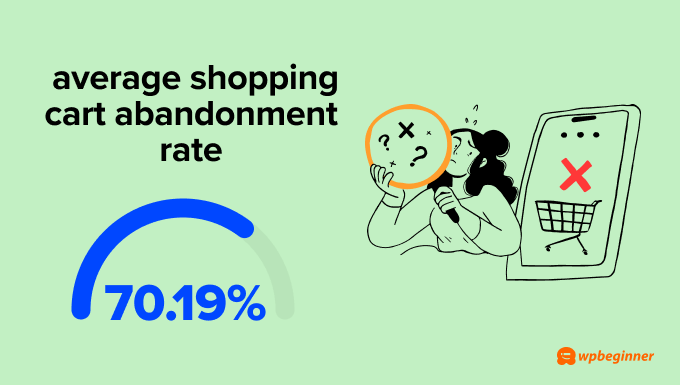

Shopping cart abandonment occurs when someone adds an item to their cart but leaves your website before checking out. And it’s way more common than you might think.
It doesn’t matter what industry you are in. You will see this happen more often than you’d like. Instead of letting it bother you, you can find ways to reduce abandonment, such as by creating a cart recovery email series.
Sending 3 emails to people who joined your list after they abandoned your cart can help you recover around 60% of lost sales. Generally, it’s a good idea to send one email after they leave, another 24 hours later, and the last one about a week after they leave with items still in their cart.
For more details, see our guide on how to set up abandoned cart emails.
24. The number one reason shoppers abandon their shopping carts is unexpected costs.
Most people have decided to abandon a shopping cart without taking action because of unexpected costs. You’d be hard-pressed to find someone who hasn’t.
That’s because shoppers expect the price at the end to be close to what they were shown when they added the items to their cart. Imagine thinking a new shirt will cost $25, only to see $60 after shipping and taxes.
You can reduce this type of abandonment by embracing an “always-on” shopping cart that shows visitors their total regardless of where they are on your site. Then, you can offer free shipping on orders over a specific amount.
25. 26% of people who leave items in their cart will go on to buy a similar item from a different store.
You may be shocked to learn that people will buy the same type of product from a different eCommerce website after they first view it on another site. This means you need to do everything you can to capture visitors’ attention so you don’t lose sales and opportunities to engage with your customers.
To win people over, there are two key areas you need to focus on: product information and enticing offers.
You can overcome hesitation by creating informative product landing pages that showcase features, benefits, and high-quality images.
Additionally, strategic discounts are a game-changer. Consider offering targeted promotions or deals specifically for recovering abandoned carts. This sweetens the deal and incentivizes customers to complete their purchase at your store instead of heading to a competitor.


This is why you shouldn’t underestimate the power of a well-timed popup. This statistic reveals that exit-intent popups, which appear when a visitor shows signs of leaving your site, can help you reconnect with a whopping 53% of departing customers.
With a tool like OptinMonster, you can streamline this process and turn more visitors into subscribers, which can later be converted into customers.
With its drag-and-drop builder, you can design beautiful, high-converting popups – even if you don’t know how to code. OptinMonster offers customizable campaigns, from exit-intent popups to lightbox forms, which lets you reach visitors at various touchpoints in their journey.
Need more proof? We used OptinMonster and managed to grow our email list by 600%!
More Shopping Cart Statistics
- 92% of visitors don’t intend to buy something the first time they land on your site.
- 54% of shoppers say they are more likely to revisit a website and complete their order if they are offered a discount.
- Despite this, only 38% of marketers say they use email to reduce abandonment.
- Organic search traffic is less likely to abandon their cart (76%) than visitors who find your site through social media (91%).
- A little less than half (46%) of shoppers have left items in their cart because a discount code they received didn’t work.
- Using predictive AI to personalize product and content recommendations can reduce abandonment by up to 18%.
- While it’s hard to pin down an exact number, experts estimate over $4 trillion worth of products are left in abandoned shopping carts each year.
Customer Experience and eCommerce Statistics
Providing a good customer experience is important if you want your eCommerce business to succeed. Here are some statistics to keep in mind.
27. 76% of people say they are more likely to buy from an online store if they personalize their shopping experience.
This stat highlights a crucial factor for eCommerce business owners: creating unique shopping journeys that resonate with each customer.
Think about it: People who see generic offers that don’t resonate with their needs will likely ignore them in favor of ultra-personalized, relevant promotions. Personalized content and product suggestions will make customers feel like you are there with them, understand their needs, and are committed to their success.
Interestingly, 85% of leaders believe they are already doing a good job personalizing content and offers, but only 60% of shoppers agree. In other words, there’s a gap that you need to be mindful of when designing your personalization strategy.
28. 95% of shoppers look for reviews and other forms of social proof before making a purchase.
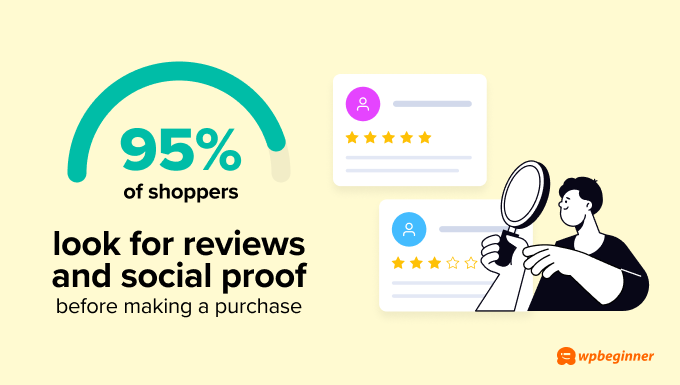

It’s impossible to deny the power of social proof in eCommerce. We bet that you look at reviews every time you buy something new online – after all, most people do.
When potential customers see positive reviews, testimonials, or user-generated content, it builds trust and validates your brand’s credibility. Imagine walking into a store and seeing it packed with happy customers – that feeling of social validation translates to the online world as well.
It’s a good idea to display reviews and testimonials on key parts of your website. The social wall plugin Smash Balloon can help with this because it lets you embed a reviews feed and show website visitors what people are saying about you on social media and other websites.
Plus consider using the social proof plugin TrustPulse to add engaging real-time live sales notifications to your site.
For more information, see our guide to the best social proof plugins for WordPress.
29. If your customer service team is unresponsive and a user has a question, 79% will leave and may never return.
You probably know that customer support is essential to your business, but did you know that 4 out of 5 people who don’t get their questions answered will leave for good? This startling statistic highlights why it’s so important to have a well-rounded customer support plan in place.
The consequences of having an unresponsive customer service team are quite severe. You’ll miss opportunities to connect with potential customers, people will think poorly of your brand, and existing customers may churn in favor of a company that offers 24/7 support.
Our advice is to use a mix of live support agents and chatbots to help your customers quickly and easily find what they are looking for.
Groove is a great help desk option that can make life easier for your support team. It allows you to quickly and easily respond to customers, track user history, create tasks, monitor feedback, and much more.
More Customer Experience Statistics
- 78% of people are more likely to place an order if there’s a fast and affordable shipping option.
- Around 35% of shoppers say they would shop online more if they could virtually try a product before they buy it.
- 48% of internet users say if a site has a bad web design, it instantly loses credibility.
- Less than 20% of people say customer service interactions with retailers exceeded their expectations.
- Solving a customer’s problem could result in them telling 4 to 6 other people about their experience.
- Globally, poor customer experiences cost businesses $75 million a year.
- 82% of people claim they are willing to spend more money on a product if they consistently receive excellent service.
The Future of eCommerce
We already know that online shopping has been growing over the years. So, let’s take a look at the future of eCommerce.
30. By the end of 2024, global eCommerce sales are projected to grow by 10% from the same time last year. Meanwhile, in-store sales are expected to see a 2% boost.
The future is bright for eCommerce businesses! This statistic paints a clear picture: online shopping is on a steady upward trajectory, while traditional brick-and-mortar stores see a more modest increase.
Plus, we expect this trend to continue in the years to come.
31. Experts predict the eCommerce market share to be worth over $8.1 trillion by 2026.


This is a very exciting prediction for eCommerce business owners across all industries. This means there’s a booming marketplace on the horizon, which translates to a wider audience for your products and more sales.
If you want to take advantage of this surge of new eCommerce traffic, make sure you are doing everything you can to align with your customers’ needs. This will give you the knowledge and experience you need to scale your business.
We recommend using a plugin like MonsterInsights to learn more about your eCommerce visitors. You can see at a glance who is visiting your site, how they found you, and more. Combine all of this data and you can learn so much about your target audience, like their needs, interests, and goals.
For more details, see our tutorial on how to set up eCommerce tracking in WordPress.
32. About 20% of all retail sales occur online. It’s estimated that this number will reach 25% by the end of 2025.
This statistic aligns with the others we have already listed – eCommerce is on the rise.
Over the course of the next year, we will see retail sales jump to 25%. This is partially due to new businesses opening up, and existing brands building a website and taking their products online.
More eCommerce Predictions
- By the end of 2025, it’s estimated that PayPal, Venmo, and other digital wallets will make up over 52% of payments.
- Most professional marketers agree that mobile eCommerce sales will reach $710 billion by 2025.
- Mobile eCommerce sales are expected to bring in $729 billion in revenue by the start of 2026.
- By the same time, subscription eCommerce will be worth an estimated $904.2 billion.
- In 2027, eCommerce revenue in the United States alone is estimated to hit $6.43 billion.
Sources:
OptinMonster, IsItWP, WPForms, AffiliateWP, TrustPulse, Shopify, Forbes, HubSpot, Constant Contact, Instapage, WebFX, Statista, eDesk, The Future of Commerce, Exploding Topics, Hostinger, Bluehost, Video Wise, Sprout Social, Backlinko, Dash, Artios, Tidio
There you have it! We hope this extensive list of eCommerce statistics helps you on your journey. If you are looking for more interesting statistics, check out some of our other posts below!
More Statistics, Trends, and Research Articles
If you liked this article, then please subscribe to our YouTube Channel for WordPress video tutorials. You can also find us on Twitter and Facebook.
WORDPRESS
Best Website Builder for an Online Store? 9 Affordable Options in 2024

Are you ready to launch your side hustle and open an online store for dropshipping, merch, or something else? E-commerce sites can be tricky to build if you don’t have the right tools, and they often require paid plans. Where can you turn if you need the best website builder for an online store?
We have you covered with everything you might need or want to know about the 9 best and most affordable options to kickstart your sales.
Ready to learn how you can grow your small businesses with online sales (and even in-person sales)? Let’s check out the best options available to you.
TL;DR: What’s the Best Website Builder for an Online Store?
Whether you want your online store to be a side hustle or your main gig, you need the right tools. I recommend Shopify as a great all-in-one solution that gets you up and running quickly. They handle everything you could need in a website builder for a reasonable monthly fee.
Remember that there are cheaper options than Shopify, but they might not be as comprehensive and robust.
On the other hand, if you already have a WordPress website, WooCommerce may be the way to go. It integrates with the rest of your website and makes it easy to transition from evergreen content to sales. Plus, it’s very cost-effective for these already-established websites.
9 Best eCommerce Website Builders
Getting an eCommerce business up and running is no small feat. Even something as simple as inventory management and finding payment gateways can be complex and overwhelming. No matter where business owners decide to build, they should be fully prepared for the costs and features available.
Here are the nine website builders you need to start selling online quickly and easily.
Shopify: Best for Building a Storefront Fast
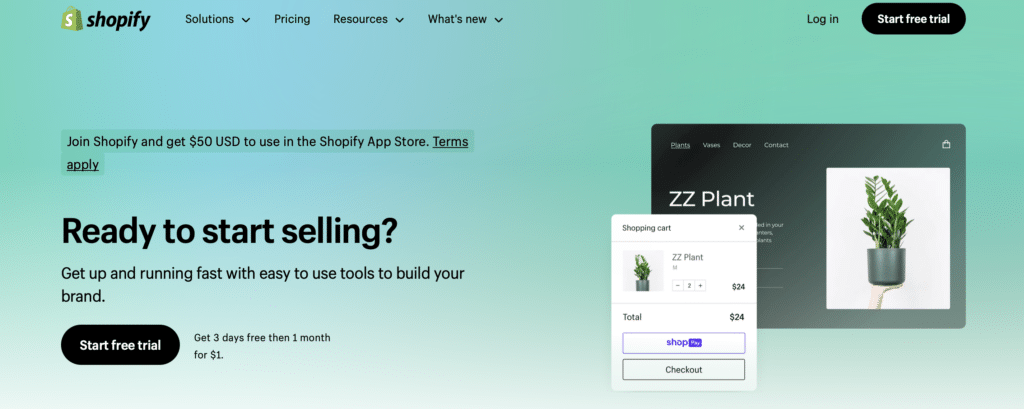
No doubt about it: Shopify is the leading ecommerce platform and website builder that many people are using to great success. There are more than 48,000 online stores that are using the framework provided here. See our full Shopify review here.
With thousands of themes to choose from for your online store, you can create something that looks custom for your brand. Add a custom domain, and you seem to have a seamless, tech-heavy storefront with minimal effort. It’s intuitive and simple to use, even for beginners.
It’s also a powerhouse for supporting your website with SEO tools, email marketing tools, payment gateways, and even a shipping function. Their paid plans offer everything you could possibly need in terms of website features.
The best part is that Shopify is extremely easy to use. I have built a couple of websites using Shopify. If I can figure it out with minimal coding knowledge, I have no doubts that you can replicate my process. Get up and running as quickly as possible to start earning.
Pricing: $29 per month and up
Squarespace: Best for Ease of Use and Services


Squarespace might be the second-best e-commerce website builder for someone with limited technical skills who wants to play around with setting up an online store. Like Shopify, it features intuitive design processes that make it easy to adapt to your custom branding.
The drag-and-drop website editor will make designing your website a breeze, no matter what niche.
You get some excellent features when you build an eCommerce website with Squarespace:
- Built-in SEO tools
- Blogging capabilities
- Mobile-optimization
- Payment gateways
- Inventory management features.
It’s a little less customizable than Shopify, but that doesn’t mean you should count it out on this alone. This website builder is also a little less expensive and has great built-in e-commerce tools, so give it a shot before deciding where to build your online store.
Pricing: $23 per month for business accounts and up
Compare whether Squarespace or WordPress is the right choice for you here.
WooCommerce: Best for WordPress Websites


If you want to create online stores on an existing WordPress site, you don’t have to recreate the wheel. You can leverage powerful tools like WooCommerce that were created specifically for this purpose. When a website is already set up with lots of evergreen content, blogs, or informational pages, you might not want to switch to an entirely new platform.
WooCommerce allows you to build a store immediately without sacrificing other plugins you might already use on WordPress like Yoast SEO or RankMath.
It even has abandoned cart recovery. This free website builder is a must-have for enhancing a WordPress site with merchandising.
I’ve built a couple of sites using WooCommerce in the past and found it very focused on intuitive use. Even my husband, who is fairly low-tech, found it easy to manage his store builder with this tool.
Website features are easy to add to this type of page regardless of whether you choose to implement a free or paid template. It also supports lots of different payment gateways, so you can choose what will work best for your business, especially if you intend to sell internationally.
Pricing: Free online store builder but may require payment for extensions
See our full WooCommerce review here.
BigCommerce: Best for Scaling Sales


Maybe you’re looking for more robust e-commerce builders that can help you scale your sales.
If this describes you, then BigCommerce might be the best website builder for an online store. What sets it apart from the other options for an online business listed here?
First, it’s great for someone who wants to sell online without limit. You get unlimited storage space and user accounts on every plan. That means you can list unlimited products without having to worry about running out of room — and you can hire the right number of people to help manage the influx.
Worried that you won’t be able to use all of the ecommerce features included here? BigCommerce will make it easy for you with an intuitive drag-and-drop editor that allows you to visualize your new page and customize an existing theme.
Plus, you can implement an ecommerce store built by BigCommerce with an existing WordPress site. Be sure to see more details in our detailed BigCommerce review.
Pricing: $29 per month for up to $50,000 in sales annually
Wix: Best Free Online Store Builder


Maybe you are looking for the best e-commerce website builder but don’t want to spend a fortune to determine whether this is the side hustle for you. The good news is that you can turn to Wix to build your online store and get off the ground quickly. Like many others, it features a drag-and-drop editor that makes design easy.
Keep in mind that it won’t be as robust as Shopify or BigCommerce, but it’s a great stepping stone for new website owners.
The one downside to using Wix as an eCommerce website builder is that it doesn’t integrate with many other tools. Email marketing tools and advanced analytics will be hard to come by. Still, it does have a few bells and whistles, like abandoned cart recovery and customer segmentation, you can leverage.
Pricing: Free ecommerce website builder up to 500MB of storage; $17 and up for additional
Shift4Shop: Best for Customization


If none of the other website builders seem like a good fit, then Shift4Shop might give you the ecommerce websites you have been looking for. Their site builder makes it extremely easy for you to get up and running with built-in payment processing that makes it easier for you to cash out.
However, their ecommerce platforms have a wide variety of functions you can use to build your site:
- Search engine optimization tools
- Inventory management
- Dropshipping capabilities
- Subscriptions
- Digital product sales.
Where it truly stands out from other online store builders is that it allows you to customize pricing for an individual client. Set up a price list for each one of your customer segmentations and you’ll have a B2B sales page that can rake in the big bucks.
Pricing: $0 for Shift4 payment gateways with $500 minimum in sales per month; $29 per month for PayPal
GoDaddy: Best on a Budget


WordPress is one of the best site builders around, but many people feel overwhelmed by the options for hosting, site building, plugins, and more. GoDaddy simplifies the process and lets you tackle building an ecommerce site with greater ease.
They provide hosting, domain registration, and even a simple site builder.
One thing to note is that it isn’t as easy to customize using their ecommerce site builder as with the Shopify or Squarespace options. It’s a solid store builder if you’re okay using a template that comes out of the box. If you’re hoping for a more custom website builder, then you would be better off choosing a different ecommerce store builder.
They also have AI that can help you create your online store in mere minutes instead of spending hours or days on a project.
Pricing: $10.99 for basic ecommerce and up
Hostinger: Best WordPress Website Builder


Looking for the best website builder for an online store and aren’t sure where to turn? Hostinger might be the solution you need for an ecommerce platform. They allow you to host your website, get a custom domain, and design your store to the exact specifications you had in mind.
Like other top ecommerce website builders listed here, this one offers a variety of ready-to-use templates to build your store. However, it also allows for customization, ensuring your website stands out and doesn’t just blend in with the rest created by similar builders.
With their drag-and-drop editor, you have lots of options with no coding required. Other functions of this ecommerce website builder include:
- Adding variants for each product quickly and easily
- Automated sales tax processing
- Shipping methods for each region where you make sales
- AI website builder.
Pricing: $2.99 per month
Square Online (Weebly): Best for Small Businesses
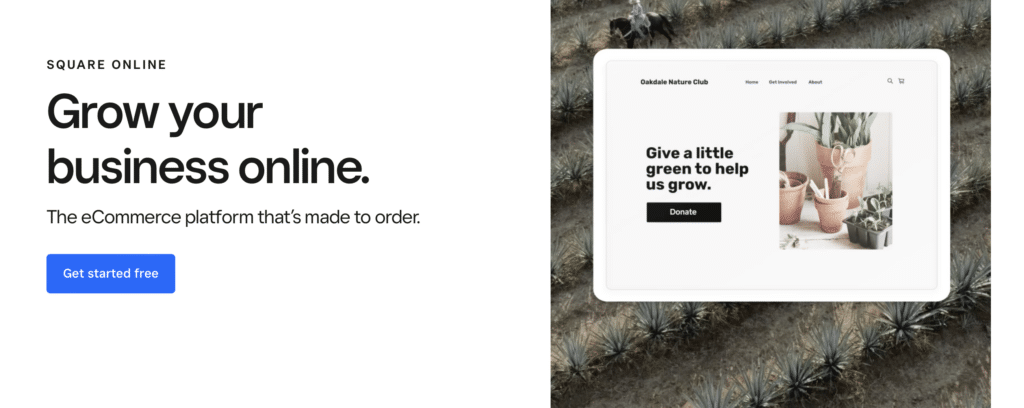

Square Online (not the same as Squarespace—see our comparison of Square vs. Squarespace here), formerly known as Weebly, is another great e-commerce site builder option. Chances are that you’re already familiar with the services Square Online offers to customers in the form of card readers, payment options, and point-of-sale software.
Now, it has many of the same capabilities as most e-commerce website builders, including payments with no additional transaction fees. However, you may face other transaction fees if you decide to use separate payment gateways instead of Square, so be sure to do your homework before deciding.
It’s a great option for anyone wanting to run a physical retail location and an online store because it syncs your inventory. This ensures that you never oversell and fail to truly deliver to your customers.
Pricing: Free plan or $29 per month for a Plus plan
Final Thoughts on the Best Website Builder for Your Online Store?
Consider what you would like to do with a new website builder when building your online store. The next right move for your brand depends on the finished product, pricing, and ease of use that you anticipate in the creation process. I recommend Shopify as the all-in-one best e-commerce website builder, but the others have their place as well.
Which of these options are the best ecommerce website builders for your unique business? Experiment and see which is easiest and most intuitive for you today!
WORDPRESS
Best WordPress Themes of All Time: Improve your Website SEO
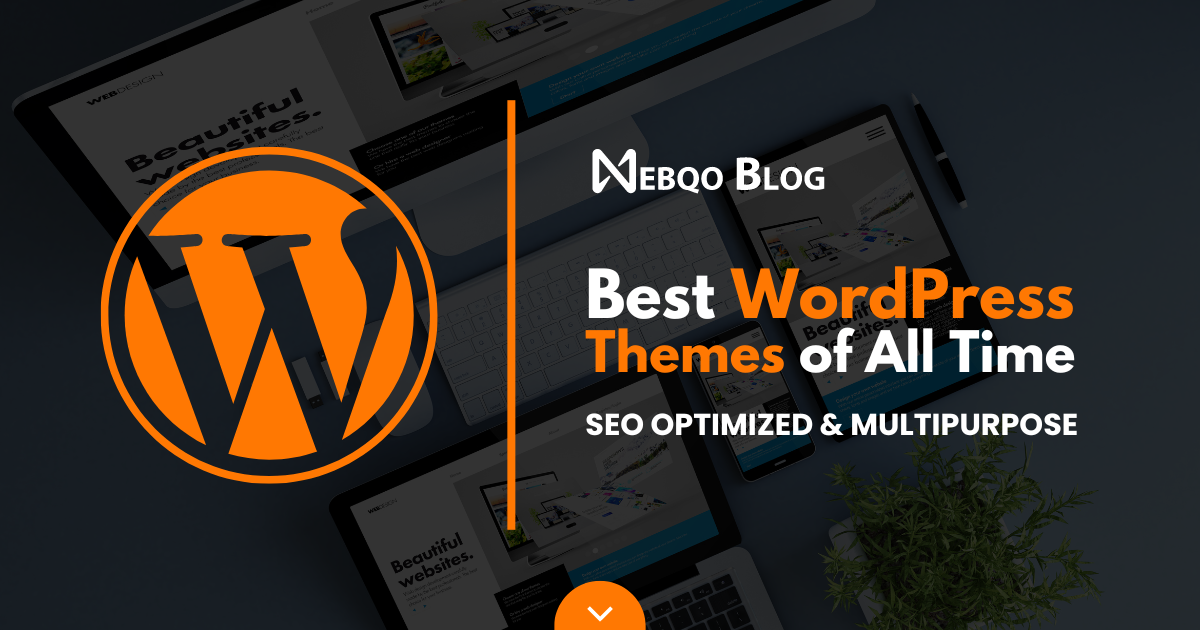
Best WordPress Themes of All Time: Improve your Website SEO
If you are looking for the best WordPress themes, you have come to the right place. Whether you need a multipurpose SEO-friendly theme or a super-fast free theme, we have covered you.
The design of your website plays a crucial role in determining its overall success. It affects various aspects, such as user experience, site speed, and conversions.
When selecting a WordPress theme for your website, it is essential to pick one that is well-coded, SEO-optimized, and secure. This ensures that your website performs optimally and ranks well on search engines.
In this post, let’s talk about:
- The best WordPress themes (including free and premium)
- Their features
- Pricing (if any)
- Download links and more
In full transparency – some of the links on Webqo Blog are affiliate links, and if you use them to make a purchase, we will earn a commission at no additional cost to you.
Best WordPress Themes of All Time
Let’s look at the 10 best WordPress themes to enhance your website.
Astra
Astra is a WordPress theme developed by Brainstorm Force, used by over 1.65 million websites worldwide. It is ideal for a fast, responsive, and SEO-optimized website. The theme offers a variety of customization options, allowing you to edit the header, blog, archives, single pages, posts, sidebar, and footer according to your preferences.
Key Features of Astra
- Gutenberg Ready
- Install it on unlimited sites
- SEO-optimized and mobile-responsive theme
- Gives you over 180 ready-to-import starter websites
- Seamless integration with page builders like Elementor, Beaver, etc
- Astra is completely WooCommerce-ready
- It comes with Schema.org code integrated
Pricing
Astra theme offers a free version with the following three premium plans:
1. Astra Pro: This plan costs $47 per year and offers hundreds of customization options. You can use Astra Pro on unlimited websites.
2. Essential Bundle: This plan costs $169 per year and gives you access to features from Astra Pro, 180+ premium templates, and the WP Portfolio Plugin.
3. Growth Bundle: This plan costs you $249 per year and gives you all the powerful tools you need, including:
- Everything in Essential Bundle
- Convert Pro Plugin
- Schema Pro Plugin
- Ultimate Addons for Beaver Builder
- Ultimate Addons for Elementor
- SkillJet Academy Membership
Does Astra offer a free version? Yes. Download Astra for Free
Divi
Developed by Elegant Themes, Divi is considered one of the top WordPress themes. It provides a robust theme framework that assists in designing every aspect of your website. Divi allows you to create stunning designs that impress your audience regardless of your business type.

Key Features of Divi
- Offers drag & drop builder
- Custom CSS
- Access to over 40 design elements
- Over 800 pre-made website layouts
Pricing
You need access to the Elegant Themes account to grab the Divi theme. Elegant Themes offers the following two pricing packages.
1. Yearly Access: This plan costs you $89 annually and gives you access to Divi Builder, Extra, Bloom, and Monarch.
You’ll also get access to the following things:
- hundreds of website packs
- product updates
- premium support
- uses all their products on unlimited sites
2. Lifetime Access: This plan costs $249, a one-time fee. You’ll get access to Divi Builder, Extra, Bloom, and Monarch.
You’ll also get access to:
- hundreds of website packs
- lifetime updates
- Lifetime premium support
- uses all their products on an unlimited number of sites
You can use this link to get a 10% instant discount on your membership.
Does Divi offer a free version? No! Buy Divi Today
GeneratePress
GeneratePress provides a comprehensive suite of tools, plugins, templates, and pre-designed websites that allow you to quickly build any website. Whether you’re creating a portfolio, an agency site, or an eCommerce platform, GeneratePress has got you covered.
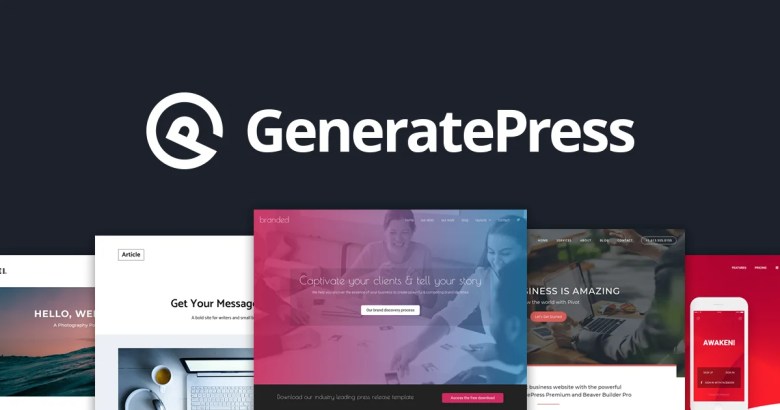
Key Features of GeneratePress
- Gutenberg Ready
- Install on up to 500 websites
- Offers a block-based theme builder
- Fully translated over 30+ languages
- Access to a ton of pre-made templates in the Site Library
- 1 year of updates and support on the yearly plan
- Lifetime support and updates on their lifetime plan
Pricing
GeneratePress can be downloaded for free. Choose one of their premium plans in the following two pricing packages for more features.
1. Yearly plan: This plan costs you just $59 per year, and you’ll get the following features:
- Full access to the Site Library
- 1 year of updates
- 1 year of premium support
- Use on up to 500 websites
2. Lifetime plan: If you want lifetime updates and support, this plan is for you, which costs you $249, and you’ll get the following features:
- All premium features
- Full access to the Site Library
- Lifetime updates
- Lifetime premium support
- Use on up to 500 websites
Does GeneratePress offer a free version? Yes. Download GeneratePress for Free
Neve
If you are looking for a fast, AMP, and Gutenberg-ready WordPress theme, Neve is the best option.
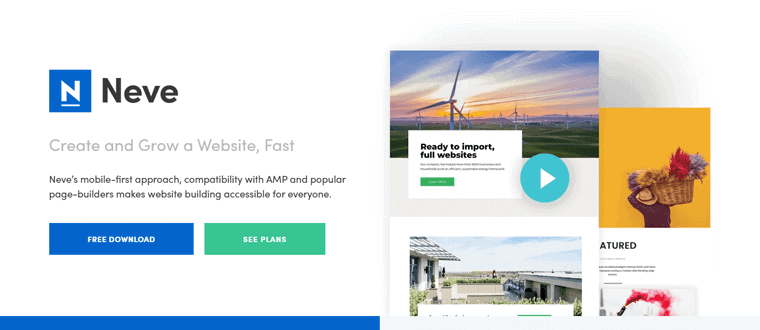
Key Features of Neve
- The theme is 100% fully responsive and adaptive to all screens
- Translation ready
- Comes with Elementor integration
- Custom layouts
- Starter sites
Pricing
Neve Theme offers a free theme version and a premium version. The premium version comes in three pricing packages, which are listed below.
1. Personal: This plan costs you $59 per year, and you’ll get access to the following things:
- Header & blog booster
- Elementor booster
- Custom layouts
- Scroll to top
- 1-Year of Support for Unlimited Sites
- 1-Year of Updates for Unlimited Sites
2. Business: This plan costs you $99 per year, and you’ll get access to the following things:
- Header & blog booster
- Elementor booster
- Custom layouts
- Scroll to top
- 1-Year of Support for Unlimited Sites
- 1-Year of Updates for Unlimited Sites
- Premium starter sites
- WooCommerce booster
- Priority support
3: Agency: This plan costs you $159 per year, and you’ll get access to the following things:
- Header & blog booster
- Elementor booster
- Custom layouts
- Scroll to top
- 1-Year of Support for Unlimited Sites
- 1-Year of Updates for Unlimited Sites
- Template Cloud Access
- Premium starter sites
- WooCommerce booster
- White label
- Priority & live chat support
Does Neve offer a free version? Yes. Download Neve for Free
OceanWP
Are you in search of a versatile and lightweight WordPress theme? Do you need a theme that can assist you in building any type of website, be it a blog, a portfolio website, a business website, or a WooCommerce store? Look no further than OceanWP, one of the most popular themes in the WordPress directory.

Key Features of OceanWP
- Fully responsive WordPress theme
- RTL & translation ready
- SEO-optimized theme
- Work with the most popular page builders, such as Elementor, Beaver Builder, Brizy, Visual Composer, Divi, and SiteOrigin.
Pricing
OceanWP offers a free version and a premium version. The premium version has three pricing packages, which are listed below.
1. Personal: This plan costs you $39 per year, and you can install it on 1 website. You’ll get the following features:
- 7 Free Extensions
- 13 Premium Extensions
- 15 Free Demos
- 158 Pro Demos
- 12 Months of Updates & Support
2. Business: This plan costs you $79 per year, where you can install up to 3 websites, and you’ll get the following things:
- 7 Free Extensions
- 13 Premium Extensions
- 15 Free Demos
- 158 Pro Demos
- 12 Months of Updates & Support
3. Agency: This plan costs you $129 per year, where you can install up to 25 websites and you’ll get the following things:
- 7 Free Extensions
- 13 Premium Extensions
- 15 Free Demos
- 158 Pro Demos
- 12 Months of Updates & Support
Does OceanWP offer a free version? Yes. Download OceanWP for Free
Avada
Avada is a top-selling theme on ThemeForest with over 959,561 users worldwide! It offers easy-to-use front-end design and editing tools for building visually stunning websites and online stores.
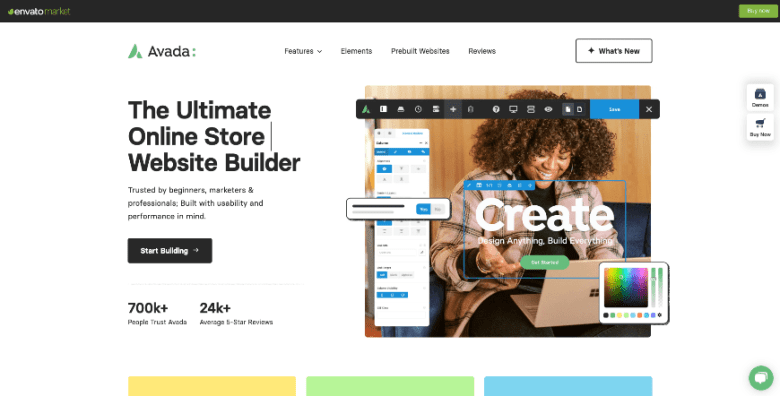
Key Features of Avada
- 100% SEO Optimized
- Built with HTML5 and CSS3
- Access to a ton of professionally designed demos that can be imported easily with one click
- Offers the most intuitive page builder on the market
- Drag and drop any of our elements
- 100% responsive theme
- Free updates for life
Pricing
Avada from ThemeForest costs $69 for a single license, which includes access to all future updates and six months of support from ThemeFusion (the developers who created the Avada theme).
Does Avada offer a free version? No. Buy Avada Today
Blocksy
If you are searching for a free, fast, and lightweight WordPress theme to easily create any kind of website, Blocksy is an excellent choice. The theme is fully compatible with the Gutenberg editor and blocks.

Key Features of Blocksy
- Fully responsive and adaptive
- Translation ready
- Integrates with all the major WordPress page builders, including Elementor, Beaver Builder, Visual Composer, and Brizy
- SEO optimized
- WooCommerce built-in
Pricing
Blocksy offers both free and premium versions. Choose the premium plans below if you need additional features and extended limits.
- A personal plan costs you $49 per year, which can be used on 1 website
- The professional plan costs you $69 per year, which can be used on 5 websites
- The agency plan costs you $99 per year, which can be used on unlimited websites
Does Blocksy offer a free version? Yes. Download Blocksy for Free
Genesis Framework
The Genesis framework is the product of a team of dedicated professionals and developers. It is a great choice if you are looking for high-performing, fully responsive, and SEO-optimized WordPress themes. In fact, over 600,000 websites around the world use the Genesis framework. The best part? The framework is completely free to use on unlimited sites.
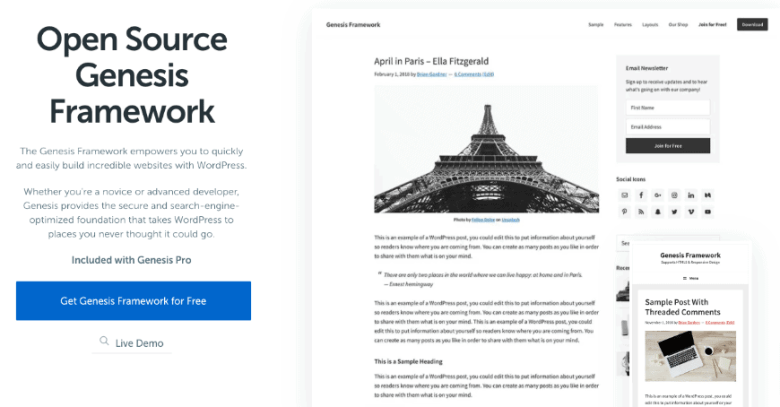
Key Features of Genesis Framework
- Access to Genesis Pro
- Access to block library
- Content sections and full-page layouts
- Custom block builder
- Free access to Genesis framework
- Use on unlimited sites
- Access to 35 StudioPress-made premium child themes
- You can use it on unlimited sites
- Access to 24/7 chat support
Pricing
Genesis framework is absolutely free forever as it is an open-source project.
To unlock more features, such as support, blocks, customizations, etc., you need access to Genesis Pro, which costs $360 annually.
Does it offer a free version? Yes. Download Genesis Framework for Free
Kadence
If you are searching for a fast and user-friendly WordPress theme, the Kadence theme is an excellent option. It provides many customization options for the layout, making it easy to modify any part of your website with just a few clicks.

Key Features of Kadence
- 20 new header elements
- Add blocks or page builder content anywhere on your site
- Menu options for mega sub-menus, highlight tags, icons, and more
- Header/Footer Scripts
- Woocommerce Addon
- Custom fonts
- Use on unlimited sites
Pricing
Kadence theme offers the following three pricing packages in its premium version.
1. Kadence Pro: This plan costs you $59 per year, where you’ll get the following features:
- Header Addons
- Hooked Elements
- Woocommerce Addon
- Ultimate Menu
- Custom Fonts
- Header/Footer Scripts
2. Essential Bundle: This plan costs $105 annually and includes everything from the Kadence Pro plan.
- Kadence Blocks Pro
- Pro Starter Templates
3. Full Bundle: This plan costs you $154 per year, and you’ll get everything from the Essential Bundle along with the following stuff:
- Child Theme Builder
- Kadence Shop Kit
- Kadence AMP
- Includes all our themes and plugins
- Access to all future products
Does the Kadence theme offer a free version? Yes. Download the Kadence theme for Free.
Zakra
If you’re looking for a multipurpose responsive WordPress theme with a performance and SEO-optimized design, consider the Zakra theme.
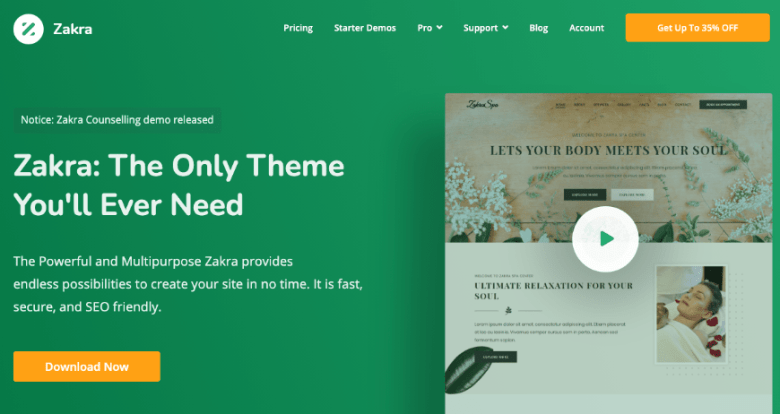
Key Features of Zakra
- Comes with 50+ different demos
- 7 widget areas
- Fully translation ready
- Fully compatible with Gutenberg
- Elementor support
- Custom CSS
Pricing
The Zakra theme is available in both free and premium versions. To unlock more features, choose one of the paid plans listed below.
1. Personal: This plan costs you $59 per year where you’ll get access to the following:
- 1 site license
- 1-year premium support
- 1-year updates
- 25+ Free Starter Demos
- 100+ Customizer Options
- 30+ Page Settings
2. Personal Plus: This plan costs you $67 per year, and you’ll get access to the following:
- 3 sites license
- 1-year premium support
- 1-year updates
- 25+ Free Starter Demos
- 30+ Premium Starter Demos
3. Professional: This plan costs $202 annually and gives you access to the following:
- 10 sites license
- 1-year premium support
- 1-year updates
- 25+ Free Starter Demos
- 30+ Premium Starter Demos
4. Developer: This plan costs you $209 annually and gives you access to the following:
- Unlimited sites license
- 1-year premium support
- 1-year updates
- 25+ Free Starter Demos
- 30+ Premium Starter Demos
Does the Zakra theme offer a free version? Yes. Download the Zakra theme for Free
Bonus WordPress Themes
WordPress Themes 2024: Most Popular, SEO Optimized & Multipurpose
Jannah
Well, let us tell you that Jannah is the WordPress theme we use in our blog.
Jannah is a beautifully crafted, powerful, and highly flexible WordPress theme designed specifically for News, Magazine, and Blog websites. The theme’s unique blend of aesthetics and utility makes it an excellent platform for various content types.

Key Features of Jannah
- Responsive for Today’s Modern Devices
- High Performance, Blazing Speeds
- Comes with different demos
- Fully translation ready
- Fully compatible with Gutenberg
- Elementor support
- Custom CSS
Pricing
Jannah from ThemeForest costs $59 for a single license, which includes access to all future updates and six months of support from TieLabs (the developers who created the Jannah theme).
Does Jannah offer a free version? No. Buy Jannah Today
X The Theme
X The Theme from ThemeForest is WordPress’s most flexible and customizable theme. It is also one of ThemeForest’s best-selling WordPress themes, with over 224,643 sales worldwide.

Key Features of X The Theme
- Fully integrated with the WooCommerce plugin
- Setup one-page navigation
- Offers dozens of navigation options, including positioning, height, centering, integrated search, etc
- Unlimited sidebars
- Custom backgrounds
- Translation ready
- Optional search functionality
Pricing
X The Theme from ThemeForest costs $79 per single license, and you’ll get all future updates along with six months of support from THEMECO (the developers who created the theme).
Does X The Theme offer a free version? No. Buy X The Theme Now
FAQs about the Best WordPress Themes
Best WordPress Themes of All Time: Most Popular, SEO Optimized & Multipurpose
You’ll discover some frequently asked questions about the Best WordPress Themes below.
How do I choose the right WordPress theme for my website?
You should choose a WordPress theme that matches the style and purpose of your website, supports the necessary features, is easy to use, and is updated regularly.
Which theme is best for WordPress?
Here are some of the best themes for WordPress.
- Astra
- Divi from Elegant Themes
- GeneratePress
Where can I download free WordPress themes?
Here are some of the best websites to download free WordPress themes in 2024.
Can I use a WordPress theme for my e-commerce website?
Many WordPress themes are designed for e-commerce websites that integrate with popular e-commerce platforms like WooCommerce.
Can I switch my WordPress theme after I’ve already built my website?
Yes, you can switch your WordPress theme at any time. However, you may need to adjust your website content and settings to ensure everything looks and functions correctly.
Quick Links
Best WordPress Themes of All Time: Most Popular, SEO Optimized & Multipurpose
We hope you enjoyed this post. If you did, you might want to check out these other resources:
Conclusion
Finding high-performance, lightning-fast, and multipurpose WordPress themes is difficult. However, we have compiled a list of the best WordPress themes to meet your website needs and save you time. Please review each theme on this page and choose the one that best suits your requirements. If you think we have missed any of your favorite WordPress themes, please let us know your thoughts in the comments section.
-

 MARKETING6 days ago
MARKETING6 days agoEffective Communication in Business as a Crisis Management Strategy
-

 SEARCHENGINES6 days ago
SEARCHENGINES6 days agoGoogle Won’t Change The 301 Signals For Ranking & SEO
-

 SEO6 days ago
SEO6 days agobrightonSEO Live Blog
-

 PPC6 days ago
PPC6 days ago9 Ecommerce Trends to Boost Your Business in 2024
-

 SEO7 days ago
SEO7 days agoHow To Write ChatGPT Prompts To Get The Best Results
-

 SEO4 days ago
SEO4 days agoGoogle March 2024 Core Update Officially Completed A Week Ago
-
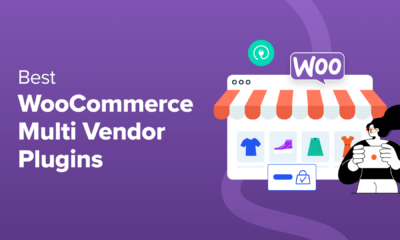
 WORDPRESS4 days ago
WORDPRESS4 days ago9 Best WooCommerce Multi Vendor Plugins (Compared)
-
SEARCHENGINES5 days ago
Daily Search Forum Recap: April 25, 2024


